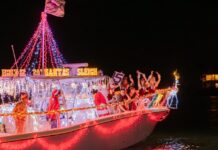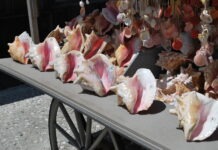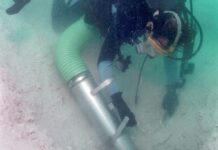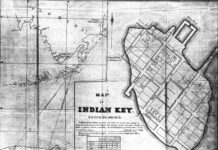Editor’s note: This is the first in a two-part series on Stock Island.
Some say Stock Island was named after the livestock that had once been kept on the island. Others say it was named after someone named Stock. While no one seems to know why the name came to be, the island’s use as a corral became entrenched within local lore. What can be said is that the name dates back to at least 1850.
As far back as 1829, livestock wandering around Key West was becoming a problem. Prior to 1829, turtle, fish and other local seafood were on the menu, but domesticated meat for consumption was the exception and not the rule on the island. Published in the March 5, 1829, Key West Register & Commercial Advertiser, the island’s new (and first) newspaper: “Two years ago fresh beef or mutton was almost unknown on the Island, and now a family would think it was faring hard indeed, if they sat down to dinner without roasting a piece of beef steak or mutton chops.”
The newspaper also made clear that livestock was roaming around the island. In a notice written by P.C. Greene dated August 27, 1829: “All person or persons having Stock of any kind running at large on this island is hereby notified that they are requested to take up the same, and confine them in a lot, or remove them from off the island within the space of thirty days.”
It could be assumed that perhaps the cows, hogs and goats were rounded up and shipped off to a little island nearby where they could be managed and confined. It could have been Stock Island. There is another contender for a nearby island serving as a natural corral, the perhaps not-so-curiously named Cow Key. Maybe both islands served the same purpose.
Like Stock Island, records for how this key came about its name are scarce. However, the following was printed in the Miami Herald on Jan. 25, 1926: “Cow Key, the name of which it is intended to change, because it has been more than half a century since it was used for the purpose from which it derived its name, was at one time a part of this island (Key West) and cattle were driven there for grazing across a neck of land that connected the two keys.”
While that story makes sense, it is not to say that there has never been livestock on Stock Island, too. Whether or not the island was used to pen livestock in the 1800s, there is evidence of cows roaming around the island in the 1920s. At least some of those cows belonged to a Conch named Eugene Fabal. The Miami Herald edition of July 21, 1921, announced: “A new dairy started on Stock Island by Eugene Fabal has 13 head of cattle. His herd is of the finest stock that can be found, having made a trip through the state to collect them.”
Eugene was the son of Miguel Fabal, who was born in Spain circa 1848 and came to Key West circa 1865. Miguel Fabal worked as a lighthouse keeper for years: Alligator Reef Lighthouse (second assistant 1882-1885, first assistant 1885-1888, head keeper 1888-1890), Sombrero Key Lighthouse (second assistant 1892-1893, first assistant 1893-1903, head keeper 1913-1919), Carysfort Reef Lighthouse (head keeper 1903-1912).
Born in Key West on Aug. 18, 1884, Eugene was one of three children. According to the Key West City Directory, Eugene was primarily a cigar maker. Apparently, he also dabbled in the dairy business. Beyond the 1921 newspaper story announcing his new dairy, there is only the hint of a mention of livestock on the island.
However, cows wandering around continued to be a problem, if not on Stock Island, then on Key West. In the Miami Herald, June 8, 1923: “Cows roaming along the county road and vicinity, destroying flowers, bushes and trees, will be stopped by the police. Mayor Ladd has started out to see this to the finish.”
On Oct. 3, 1925, the Miami Herald printed: “Dreamland café and the bungalows near it, both of which are now owned by Martin Key, are now on the market according to signs on the former building. Those structures, with the exception of a small one used years ago in connection with a stock farm, were the first to be erected on Stock Island.”
Was that structure part of Fabal’s former dairy farm or some forgotten building from years past that served a different farm? It is clear that while cows may or may not have been the reason Stock Island came about its name, the island has some history with livestock. The island living in the shadows of Key West does have other stories to tell, too.
Stock Island became a playground for those living in Key West and the Lower Keys. About the same time that Fabal was operating his dairy farm on the island, plans were being made to develop Stock Island into a recreational haven. A story printed in the Miami Herald on Feb. 9, 1923, addressed the idea of creating a golf course: “It is known that many visitors, who stated that they would have stayed here the remainder of the season could they have played golf, have gone up to Miami or across the gulf to Havana to participate in the sport.”
While the golf course has been a primary focus on the island for just over a century, Stock Island was once home to stock car races, dog races and a drive-in theater. Those stories will continue next week.


























